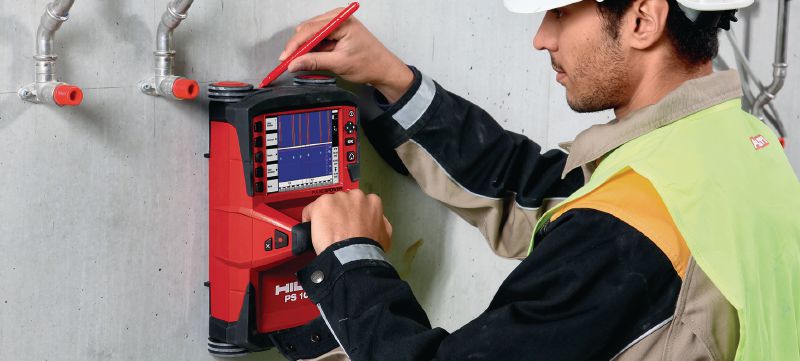Advanced RainierGPR Concrete Scanning Services Introduced
Advanced RainierGPR Concrete Scanning Services Introduced
Blog Article
Exploring the Depths: A Comprehensive Guide to Concrete Scanning and Its Diverse Applications
In the world of construction and facilities advancement, the thorough procedure of concrete scanning holds a crucial role in guaranteeing the architectural honesty and safety of projects. As technology continues to evolve, the applications of concrete scanning have expanded much beyond mere surface-level analyses.
Value of Concrete Scanning
Comprehending the relevance of concrete scanning is crucial in ensuring the safety and stability of structures throughout construction and restoration projects. Concrete scanning uses innovative technologies such as ground-penetrating radar (GPR) and electromagnetic induction to discover embedded things, voids, or various other abnormalities within concrete structures.
Furthermore, concrete scanning plays a pivotal function in guaranteeing conformity with building regulations and regulations that mandate the defense of existing structural elements throughout building and construction activities. By accurately drawing up the internal make-up of concrete, scanning technologies make it possible for construction specialists to make enlightened decisions that maintain the architectural stability and sturdiness of buildings and infrastructure projects. In essence, the significance of concrete scanning lies in its capacity to safeguard both the architectural honesty and the workers associated with construction undertakings.
Technologies Used in Concrete Scanning
Concrete scanning relies on sophisticated modern technologies such as ground-penetrating radar (GPR) and electro-magnetic induction to properly detect ingrained items and abnormalities within concrete frameworks. Ground-penetrating radar operates by discharging high-frequency electromagnetic waves into the concrete.
Electro-magnetic induction, on the other hand, functions by creating magnetic fields around a concrete framework via a transmitter coil. When metal things exist within the concrete, they disrupt these magnetic fields, creating eddy currents to flow with the metal. By gauging the adjustments in the electro-magnetic areas with a receiver coil, the system can pinpoint the location of metal things in the concrete.
These innovative modern technologies play a vital role in non-destructive testing, making sure the security and stability of concrete structures in various sectors.
Applications in Building And Construction Market
Within the construction market, concrete scanning modern technology locates diverse applications that enhance project effectiveness and security. Furthermore, concrete scanning is used for locating voids, such as air pockets or locations of deterioration within concrete, which can compromise the total strength of a framework. Concrete scanning plays a vital function in high quality control by verifying the density of concrete covers over support, guaranteeing compliance with layout specs and requirements.

Safety And Security Advantages of Concrete Scanning
In the realm of building and construction security, the execution of concrete scanning innovation offers a critical advantage in preemptively identifying prospective risks and fortifying structural stability. By using hop over to here sophisticated scanning approaches such as ground-penetrating radar (GPR) and electro-magnetic induction, construction teams can accurately find rebar, post-tension cords, avenues, and other concealed items within concrete structures. This positive method dramatically decreases the risk of unintended strikes during drilling, cutting, or coring activities, thereby avoiding costly problems, injuries, and task delays.
Additionally, concrete scanning boosts worker security by providing real-time details about the architectural condition of concrete elements. By dealing with potential safety and security worries quickly, concrete scanning adds to creating a safe and secure working environment and minimizing the possibility of structural failures or crashes on construction sites.
Future Fads in Concrete Scanning
Emerging innovations in scanning innovation are positioned to reinvent the field of concrete assessment and analysis. One major fad that is obtaining traction is the combination of synthetic intelligence (AI) and maker discovering formulas into concrete scanning gadgets. By using the power of AI, these systems can analyze huge amounts of information accumulated throughout scanning procedures to give even more comprehensive and exact insights right into the problem of concrete frameworks. This can assist in identifying covert flaws, anticipating possible architectural failings, and also advising upkeep techniques.
Another substantial fad is the development of more mobile and user-friendly scanning tools. Miniaturization of scanning equipment permits less complicated access to restricted rooms and remote areas, making look at this site examinations extra comprehensive and effective. Furthermore, improvements in wireless communication technologies make it possible for real-time information transfer and evaluation, promoting quicker decision-making procedures.
Additionally, there is a growing concentrate on sustainability in concrete scanning modern technologies - RainierGPR Concrete Scanning. Producers are progressively incorporating green materials and energy-efficient functions right into their gadgets to lower environmental influence. These future trends are set to enhance the performance, precision, and sustainability of concrete click here for more scanning techniques, forming the industry's future landscape
Final Thought
In verdict, concrete scanning plays a crucial duty in the construction sector by making sure the safety and effectiveness of numerous jobs. By making use of sophisticated technologies, such as GPR and radar imaging, professionals are able to properly find prospective threats within concrete structures. The applications of concrete scanning are vast and remain to evolve, making it a vital tool for keeping the stability of buildings and framework. As innovation developments, the future of concrete scanning holds encouraging advancements for boosting construction procedures.

Report this page